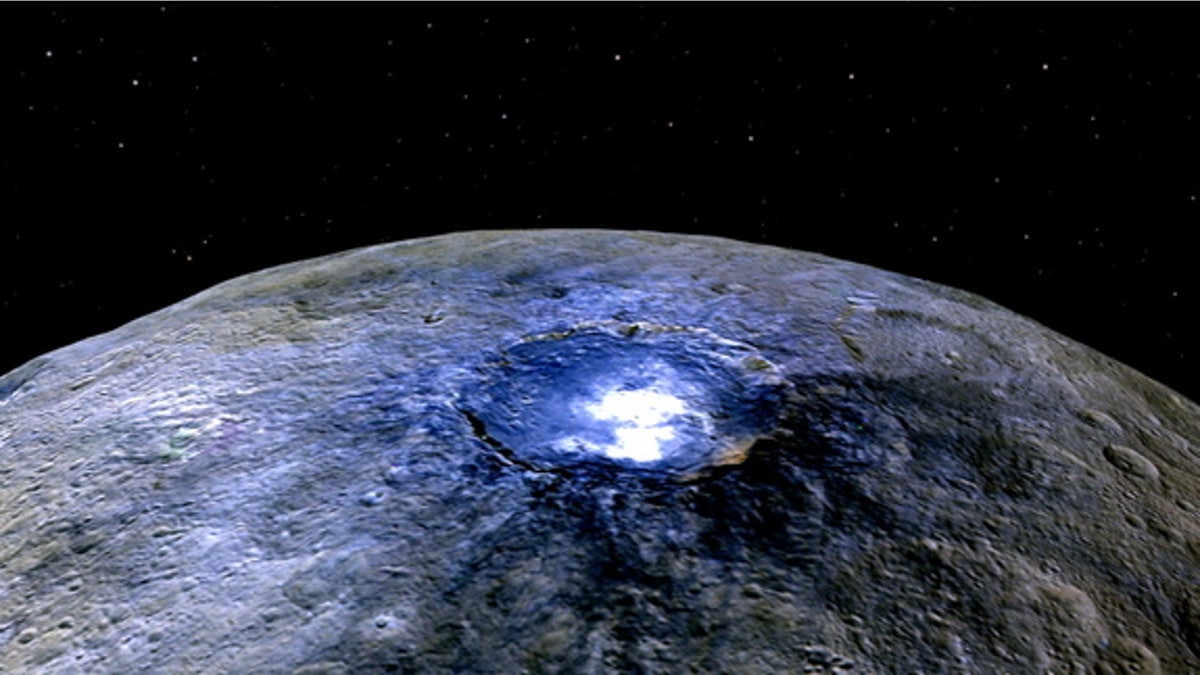
False-color view of Occator Crater showing differences in surface composition. Red corresponds to a wavelength range around 0.97 micrometers (near infrared), green to a wavelength range around 0.75 micrometers (red, visible light) and blue to a (NASA/JPL-Caltech/UCLA/MPS/DLR/IDA)
The bright spots on the dwarf planet Ceres have confounded NASA so much that it actually reached out to the public for help.
Now, a team of researchers has some answers.
In a paper published Wednesday in the journal Nature, Andreas Nathues and his colleagues documented 130 spots on Ceres ranging in brightness from the color of concrete to ocean ice. It also found these “unusual areas” of brightness are consistent with the presence of “hydrated magnesium sulfates mixed with dark background material.”
On Earth, a different type of magnesium sulfate is familiar as Epsom salt.
Related: Ceres’ bright spots still shrouded in mystery
“Of particular interest is a bright pit on the floor of crater Occator that exhibits probable sublimation of water ice, producing haze clouds inside the crater that appear and disappear with a diurnal rhythm,” the researchers said of the crater that is about 55 miles wide and 2.5 miles deep.
The results suggest Ceres is the first large body in the main asteroid belt to display "comet-like activity."
NASA’s Dawn spacecraft successfully entered Ceres' orbit March 6, making history as the first mission to achieve orbit around a dwarf planet. With a diameter of about 590 miles, Ceres is the largest object in the main asteroid belt.
Related: NASA’s Dawn spacecraft prepares for Ceres rendezvous
Along with the spots, researchers have in the past discovered evidence of water on Ceres in the form of vapor plumes erupting into space. Minerals were also found but they couldn’t be identified because certain critical wavelengths could not be observed.

This artist's illustration shows two different hypotheses regarding the formation of Ceres. Top: Ceres formed in the main asteroid belt, and ammonia was incorporated from the solar system's outer reaches. Bottom: Ceres itself formed far from th (L. Giacomini)
But in a related study in Nature also Wednesday, Maria Cristina De Sanctis and her colleagues have identified those minerals and concluded the dwarf planet may have formed in the outer solar system.
Using the Visible-Infrared Mapping Spectrometer on the Dawn spacecraft, they obtained new spectral data acquired from a distance of 50,952 miles to 2,671 miles from the surface of Ceres. These measurements showed that ammoniated phyllosilicates was widespread on the surface of the dwarf planet and that ammonia, incorporated into the planet either as organic matter or as ice, may have reacted with Ceres’ clays during its formation.
Related: Could the dwarf planet Ceres support life?
Since ammonia is stable only at cold temperatures of the outer Solar System, it would suggest that Ceres formed before reaching the main asteroid belt or that pebble sized objects were transported from that region and incorporated into the main asteroid belt.
If it did form in the outer solar system, the researchers suggest it was probably in the “the trans-Neptunian disk, before being subsequently implanted in the main belt.”
“This view is corroborated by the presence of ammonia ice on other large trans-Neptunian objects, such as Orcus and Charon,” the researchers wrote. “The implantation of Ceres in the main belt could have taken place during a migratory phase of the giant planets, either during their growth in the protoplanetary disk, or at a later time as a result of an orbital instability.”




















